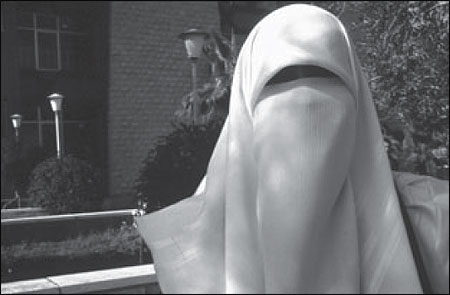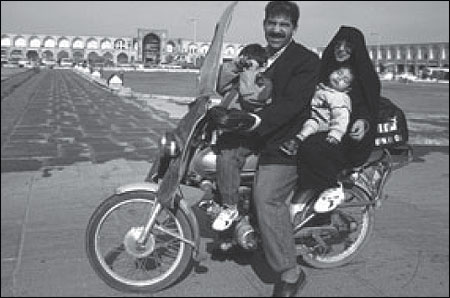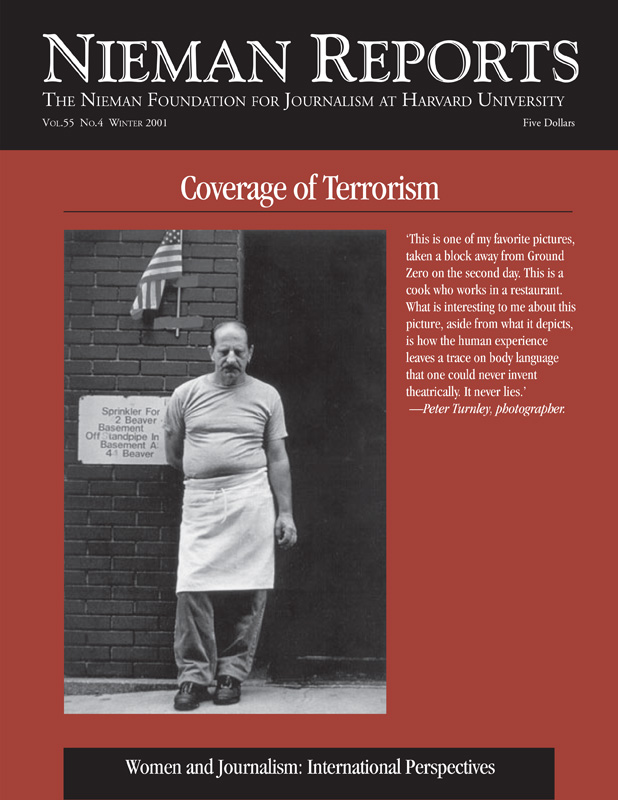
“This young woman is totally veiled and studies at the University of Irbid, Jordan. It always surprised me to see women in such clothes, because in Jordan there is no law that forces women to be veiled like in Iran. But some of them do it because they are convinced that it is the right way of life for themselves.”— Katharina Eglau. Photo by Katharina Eglau.©
When I tell strangers and acquaintances I am an Iranian-American who travels frequently between the two countries, I am often asked whether it is difficult for me, as a woman, to be in Iran. Many of us have spent hours describing the degree of freedom that exists in Iran and explaining how Iranian women’s situation is different from that of Saudi or Afghan women. In Iran, women are not always in the house, nor do they spend all their time thinking about the veil on their head, nor does every man have many wives. And, yes, even a single woman can buy a bus ticket in Iran.
The primary source of information about Iran is the media, given that few from North America and Europe travel there these days. Considering the prevalence of misperceptions about life in Iran, it seems important to ask what the media might do differently in its coverage of Iranian women.
It’s been 22 years since the image of angry women, covered from head to toe in black cloth and shouting anti-American slogans, entered the consciousness of Western media. Since the 1979 Iranian Revolution, women in this country have been a focus of Western fascination. In this time, the changes that occurred in the status of women—particularly compulsory veiling and stricter marriage and family laws—have become the main line of differentiation between Iran and more “modern” countries. They are regarded as the ultimate sign of a country moving backwards.
During the 1990’s, another type of change took place both within Iran and in its relation to the outside world. Iranian cinema presented international viewers with images other than bearded men and veiled women. More foreign journalists (including some Americans) were allowed into the country. And most importantly in 1997, with President Mohammad Khatami’s election, the Islamic Republic of Iran emerged in the West as no longer an angry country but one struggling to release itself from the grips of its founding moment—that of the Islamic Revolution.
Through this time, the veiled Muslim woman has remained the image of Iranian women in the international media. At first glance (both literally and symbolically) this makes perfect sense. Anyone who travels to Iran is inevitably confronted with this most obvious difference. Women are seen on the streets wearing veils, some happily, some not, many indifferently. And for many journalists who travel to Iran, who visit with middle-and upper-class families, the issue of compulsory veiling and other limitations on women’s rights are often the first things that are discussed.
It is thus rare to read a news report about the social and cultural situation in Iran without a mention of veiled women. In these reports, a veil is used to either demonstrate a person’s conservative viewpoint or to show the opposite—that despite the veil, a woman holds views close to our own more liberal, democratic ones. A recent article in The New York Times’s “Week in Review” clearly demonstrates this point: While in one section the article states that Iranian women’s wearing of the veil has led to their loss of freedom and rights, in another the writer notes the important role women have played in Iran’s recent politics, “their covered heads and bodies notwithstanding.” The problem, of course, is that because veiling is compulsory in Iran it is hard to use it as an indicator of any individual’s political views.
There are many women—some more vocal proponents of women’s rights in Iran—who would still wear a veil regardless of the law and who are against it being compulsory. Some of the country’s more politically and socially active women are practicing Muslims; their objection to compulsory veiling stems not from their belief that the veil itself is oppressive, but rather from knowing that a law deprives women of their freedom to choose their clothing. These women, therefore, are not a moderating or reformist force “despite their veil.” The veil, itself, has very little to do with their political stance.
Since 1997, there has been a shift toward articles that focus on the numerous women journalists, activists, parliamentarians and other public figures in Iran. There is also an increasing number of articles about Iranian youth, with special emphasis on younger women as the strongest force for reform in contemporary Iran. This shift is an important and welcomed one, reflecting the changing situation in Iran and the increased access of Western journalists to it.
Despite this positive change, a good number of articles still operate within a conventional framework and utilize stereotypes. The success of female public figures in Iran and the presence of Iranian women in the streets are often presented against the backdrop of the readers’ (and sometimes the journalists’) expectation that because the women are veiled and living in a Muslim country, they lack certain rights, behave in certain (traditional/conservative) ways, and hold certain views. This juxtaposition of look, beliefs and actions provides such reports with a sensationalist, shocking, or “newsworthy” quality: See the traditional woman act in modern ways.
Gender inequality is now the most common window through which the West reports on Iran. Yet other issues are of concern to Iranian women, and these concerns are ones that journalists could report on and other media could do a better job of portraying. But to do so means moving beyond the customary model for reporting on Iranian women.
Considering the constraints placed on journalists traveling to and reporting on Iran, how can the coverage of Iranian women in the international media be improved?
Here are four interconnected suggestions:
Don’t start reporting with preconceived assumptions. The framework within which stories about women are sought and written about needs to change. If we start with the assumption that Iranian women are some of the most repressed women in the world, then anything that counters that image will be seen as heroic, subversive and unusual. The rise of Islamic movements in different parts of the Middle East in the 1990’s and the Taliban in Afghanistan have for now fixed in the international mind the idea of Muslim women (marked by their veil) as oppressed by a Muslim patriarchy. It is against this image that much of the coverage of Iranian women occurs and many articles are read. The prevalent assumption that treats all women living in Muslim countries the same (regardless of country, social, economic and cultural factors)—an assumption that does not correspond to reality—is the cause of some of the problematic reporting we see.
Don’t think in terms of “Iranian women.” Ask how relevant the broad category “Iranian woman” is to the story being reported. For example, rarely do we see articles speaking about “French” or “Italian” or “European” women. To speak about those women as though they are a collective with the same problems, reactions and predicaments would not be considered good journalism. Yet when Iranian women are written about—even when reporting on a particular artist, attorney, writer, or politician—the focus shifts from the individual’s work to her life as an Iranian or Muslim woman. Many Iranian women who become the focus of the international media’s attention and fascination are aware of the kind of boxes they are put into and often express frustration over this, noting how most of the questions asked of them by foreign journalists focus more on being an “Iranian woman” and less on their work.
Ask different questions. The most important way to change our framework is to begin asking different questions. Familiar questions sound like this: “What do Iranian women want?” “What are the problems of Iranian women today?” “How can a woman be veiled and a feminist?” “How does it feel to be a woman in the Islamic Republic of Iran?” But these questions have limited utility. Instead, ask questions that will provide a broader context for deeper understanding. Instead of asking, “What do Iranian women want?” ask questions that add to gender issues other factors such as economics, religious beliefs, and demographic information. When interviewing various women, determine their background (Are they from Tehran or the provinces? Are they upper, middle, or working class? How relevant are their views/positions to their demographics, and how much relevance does this have to their being women?) Ask questions that allow individual women to hold myriad positions; don’t box her into speaking for “Iranian women.” The image of the veiled (thus Muslim) woman has become so all-consuming and stands in for so many things (political beliefs, economic status, demography) that, in using it, we lose sight of important differences when reporting on women who live in Iran.
Learn about Iran before asking questions. The two most important constraints on those writing about Iran are language and unfamiliarity with the subtle shifts and changes in Iranian society. Other than a handful of journalists who reside there, most travel to Iran for limited periods of time and operate under the pressures of navigating a difficult and different society. Fortunately, various resources are available to journalists both in and outside of Iran. An increasing number of Iranian-Americans (or Iranian-Europeans) travel to and live in Iran and can serve as sources of information. Because their relation to both societies is not just based on formal information (books, newspapers, interviews), they are in a position to understand the subtleties of Iranian society while at the same time appreciate some of the difficulties journalists face in trying to explain these subtleties to their readers. There are also Web sites, journals and online magazines that attempt to create precisely the kind of contextual information necessary for better coverage of Iran and Iranian women. The most important of these is www.badjens.com and www.tehranavenue.com. The former, in particular, was created to specifically address the problems outlined in this article and to allow those outside of Iran to see women in Iran not as Muslim/Iranian women but as they see themselves.
This critique of media coverage of Iranian women is a tricky one to articulate. I am aware that at times it implies that unless journalists are part of a culture, they cannot accurately cover it. Or that at times such criticism veers into a kind of cultural relativism that seems to make any type of general statement problematic. Neither of these conclusions is my intent. The job of journalists covering a culture and society so different from their own is a difficult one, and in Iran this difficulty is compounded by restrictions on the flow of information and, at times, by the contradictory nature of changes taking place inside of it. But it is precisely for these reasons that the job of journalists reporting on Iran, and particularly about women in Iran, requires a higher degree of self-criticism and awareness of the assumptions brought into the reporting.
The complexities of these women’s lives might be difficult to report, challenging to write, and slow to be embraced by readers. But they are also the stories worth telling. 
“In Iran, the motorbike is very popular. Whole families travel on one motorbike because they cannot afford a car.”—Katharina Eglau. Photo by Katharina Eglau.©
Naghmeh Sohrabi is a Ph.D. candidate in Middle Eastern history at Harvard University. She has worked as an interpreter for various journalists in Iran and the United States and is a regular contributor to the online magazine Iranian.com.



